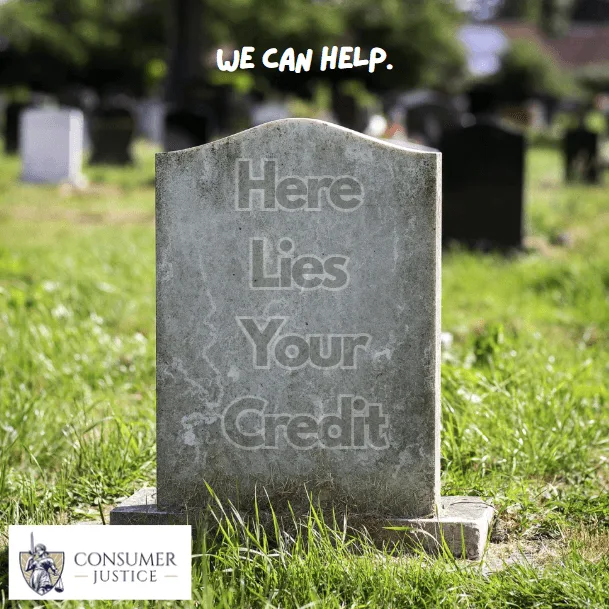Seeing the words “Consumer Deceased” on your credit report when you are very much alive is more than unsettling, it can have serious consequences. A deceased indicator can prevent you from opening credit accounts, renting a home, securing a loan, or even passing a background check. If your credit report shows you as deceased when you’re alive, it’s essential to take immediate action.
Consumer Justice Law Firm helps people who have been falsely reported as deceased by the credit bureaus. If this happens to you, we can help. Keep reading to learn what a deceased indicator means, what causes it, how to fix it, and what legal rights you have.
What Is a Deceased Indicator on Your Credit File?
If you’ve been mistakenly reported as deceased on your credit report, it’s likely you will receive a deceased indicator. A deceased indicator is a flag placed on your credit file by a credit bureau that suggests the consumer is deceased. It can appear as “Consumer Deceased” or a code that prevents lenders from accessing your report or issuing credit.
So what does “Consumer Deceased” on a credit report mean? It essentially tells creditors and institutions that the individual is no longer living and that the credit file should not be used for any new activity. Unfortunately, if this appears in error, it can leave you financially frozen, unable to apply for credit or verify your identity.
Where to Find a Deceased Indicator
If you’re wondering “Where is a deceased indicator located on your credit report?” – it can sometimes be found in the personal information section or noted within an account’s status or comments, but the exact location will vary depending on the credit bureau.
Do This to Remove a Deceased Indicator from Your Credit File!
If your credit report says you’re deceased, follow these steps to get the error corrected:
Step 1: Get Your Credit Reports
If you’ve ever asked, “Why does my credit report say I’m deceased?” – you’re not alone. To fix this, you should first request your full credit reports from Equifax, Experian, and TransUnion. You’ll need to confirm which bureau (or bureaus) has reported you as deceased.
Step 2: Contact the Credit Bureau Reporting the Error
Write a formal dispute letter to the credit bureau that reported the deceased status. Explain that you are alive and that the deceased indicator was applied in error. Include a copy of your government-issued ID, proof of your address, and a brief, clear statement confirming you are not deceased. Also attach a copy of your credit report highlighting the incorrect information.
Step 3: Request the Bureau Remove the Deceased Flag
Ask the credit bureau to remove the deceased status and restore your active credit file. Under the Fair Credit Reporting Act (FCRA), they are required to investigate and respond within 30 days. Be sure to send your dispute via certified mail and keep a copy for your records.
Step 4: Monitor Reports and Follow Up if Needed
Even after removal, continue monitoring your reports to ensure the deceased indicator doesn’t return. If it does, or if the bureau refuses to fix it, you likely need legal help.

Step 5: Get Legal Help
With free consultations and zero money out of pocket to work with one of our experienced consumer protection lawyers, you can safely and affordably get legal help when you need it.
What Causes a Deceased Indicator on Your Credit Report?
Several things can trigger a false death report. The most common cause is a creditor mistakenly notifying the credit bureau that a consumer has died. This can happen due to a system error, human mistake, or even confusion when two consumers share a similar name, address, or Social Security number.
Another potential source is the Social Security Administration (SSA). Errors in SSA records can result in an incorrect death notice being passed along to the credit bureaus. This is sometimes referred to as an Equifax death notification or Experian death notification, depending on which bureau received and published the information.
You might also be wondering what to do if your credit report says you’re deceased and the SSA has no such record. If the SSA did not issue a death notification, the credit bureau is likely acting on misinformation – sometimes from a lender or data mismatch.
Here are the most common causes of a false deceased indicator:
- A creditor or lender mistakenly reports a customer as deceased after account closure, joint account holder death, or identity mix-up.
- Data mismatches or typos when Social Security numbers, names, or birthdates closely resemble someone who has recently passed away.
These types of errors often happen through no fault of your own, but the consequences can be severe. That’s why it’s critical to act quickly and to know your rights under the Fair Credit Reporting Act.
Get Justice: Legal Help When You’re Mistakenly Reported as Deceased
If you’ve been mistakenly reported dead by a credit bureau, you may have legal options. Being falsely reported as deceased can prevent you from working, buying a home, or simply managing everyday life. Under the FCRA, you may be entitled to compensation for the harm this has caused.
A deceased credit report attorney can help you file a claim, demand the removal of the false deceased indicator, and pursue financial compensation if the credit bureau refuses to fix the error. You may be able to recover actual damages, statutory damages, and even have your legal fees covered.
Consumer Lawyers You Can Trust!
Found yourself searching for “Consumer Protection attorneys near me”? Yep, that’s us! We’re nationwide. At Consumer Justice Law Firm, we help people like you correct credit report errors and fight back against credit bureaus that don’t take their legal responsibility for accuracy seriously. If your credit report falsely says you’re deceased, contact us today to learn how we can help.